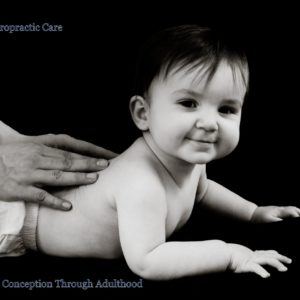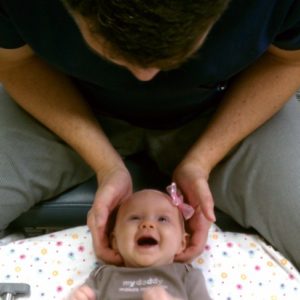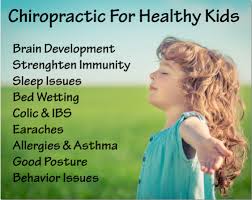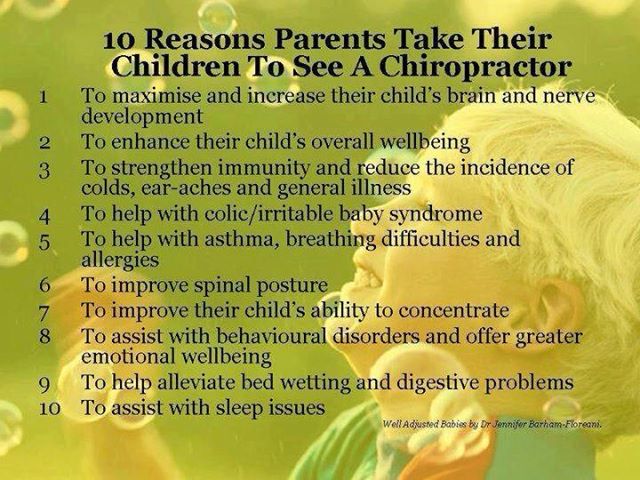 Healthier Children With Chiropractic
Healthier Children With Chiropractic
“Chiropractic care for my child? Why? Her back doesn’t bother her.” Many parents appreciate the importance of regular checkups for their children’s teeth, hearing and vision but draw a blank when it comes to a chiropractic checkup. A chiropractic checkup could be one of the most important checkups your children will ever have! The spine and structural system protect billions of nerve fibers that send messages and energy to every part of their bodies.
Nerve & Energy Blockages
If there is blockage of any of the nerves in the body, any nerve damage at all, then a state of “dis-ease” can develop. Dis-ease is a state of disharmony in the body which can lead to lowered resistance to disease, organ malfunction (including brain malfunction), sickness and disease.1 Blockage of nerves in the spine and structural system is usually caused by subtle structural distortions that are known as subluxations.
The First Subluxation
How can your child’s body lose its natural alignment and develop subluxations? Subluxation damage can be caused by a constricted uterus, a breech presentation or a difficult delivery. Health problems in childhood or even adulthood have been traced back to spinal and structural damage at birth.
 Immediately after birth, damage can occur if the baby is handled poorly. As the famous French obstetrician Frederick Leboyer has written in Birth Without Violence:
Immediately after birth, damage can occur if the baby is handled poorly. As the famous French obstetrician Frederick Leboyer has written in Birth Without Violence:
We know very little about our bodies, so little that we forget the importance of the spine…. Why, when the vulnerable spine has always been curved, do we insist on holding the newborn upside down and jerking the back straight? 2
Toddlerhood Through Childhood
Toddlerhood through childhood is a very “physical” time. Those first hesitant steps soon evolve into jumping, running, falls and accidents which are all part of a normal childhood. While most falls are minor, at times they can cause nerve-damaging subluxations with serious long-term consequences.3 For that reason all children need periodic chiropractic checkups.
A Family Affair
Doctors of chiropractic love to see the whole family, from babies to grandparents, coming in for checkups. Many “chiropractic families” report having more energy, improved health and less dependency on drugs and medication. It is not unusual to hear parents state that since starting chiropractic care their children get sick less frequently and less severely, have less ear infections and take less antibiotics and other drugs than their classmates.4
Physical & Psychological Benefits
For decades parents, clinicians and researchers have noticed positive changes in the behavioral, physical and emotional health of children under chiropractic care. Among the observed benefits are improvements in children with hyperactivity, low mental stamina, autism, anxiety, asthma, lack of concentration and discipline problems. Improvements in grades and IQ have also been recorded.5-10
The mechanisms explaining these results are varied. There is evidence that subluxation correction improves blood flow to the brain.11
Chiropractic Checkups Are Vital
If your child is suffering from any of the following common conditions, it is essential to get his/her spine and body checked for subluxations— not as a treatment for these conditions, but because all children, especially if they are ill, need healthy bodies. Being free of blockages to the flow of energy and information over his/her nervous system can make a big difference in your child’s physical and emotional health.
not as a treatment for these conditions, but because all children, especially if they are ill, need healthy bodies. Being free of blockages to the flow of energy and information over his/her nervous system can make a big difference in your child’s physical and emotional health.
- Vision problems
- Skin conditions
- Sinus problems
- Weakness or fatigue
- Poor concentration
- Stomachaches
- Asthma and wheezing
- Loss of hearing
- Ear infections
- Eye problems
- Painful joints
- Hip, leg or foot pain
- Constipation
- Poor coordination
- Breast-feeding difficulties
- Arm, hand or shoulder pain
Warning Signs
Because it is possible to have subluxations yet be symptom-free, all children (and their parents!) need periodic chiropractic checkups. There are, however, certain warning signs indicating that the spine and structural system may be out of alignment:
- Fatigue
- Joint aches
- Shoulder blades flared out
- One arm looks shorter
- Hyperactivity
- Neck tilt
- Frequent falling
- One leg looks shorter
- “Noisy bones”
- A foot turned in or out
- One hip or shoulder higher than the other
Conclusion
More and more families are finding that periodic chiropractic checkups for their children make a big difference in their health. Include chiropractic checkups as part of your family’s healthcare routine.
To schedule an appointment for your child, please call Performance Chiropractic at (661) 942-5000.
References
1. Al-Jishi A, Sreekantaswamy. Dystonia associated with atlantoaxial subluxation. Clin Neurol and Neurosurg. 2000;102(4):233-235.
2. Leboyer F. Birth Without Violence. New York: Alfred A. Knopf, 1984:21,28.
3. Eleraky MA, Theodore N, Adams M et al. Pediatric cervical spine injuries: report of 102 cases and review of the literature. J Neurosurg. 2000;92(1 Suppl):12-17.
4. van Breda WM, van Breda JM. A comparative study of the health status of children raised under the health care models of chiropractic and allopathic medicine. Journal of Chiropractic Research. Summer 1989:101-103.
5. Giesen JM, Center DB, Leach RA. An evaluation of chiropractic manipulation as a treatment of hyperactivity in children. JMPT. 1989;12:353-363.
6. Lovett L, Blum CL. Behavioral and learning changes secondary to chiropractic care to reduce subluxations in a child with attention deficit hyperactivity disorder: a case study. JVSR. October 4, 2006;1-6.
7. Gorman RF. Chiropractic Medicine for Rejuvenation of the Mind. Darvin, Australia: The Academy of Chiropractic Medicine, 1983.
8. Gibbons PF, Gosling CM, Holmes M. The short-term effects of cervical manipulation on edge light pupil cycle time: a pilot study. JMPT. 2000;23(7):465-469.
9. Pauli Y. The effects of chiropractic care on individuals suffering from learning disabilities and dyslexia: a review of the literature. JVSR. January 15, 2007;1-12.
10. Pauli Y. Improvement in attention in patients undergoing network spinal analysis: a case series using objective measures of attention. JVSR. August 23, 2007;1-9.
11. Carrick FR. Changes in brain function after manipulation of the cervical spine. JMPT. 1997;20(8):529-545.